A child's birthday party, a party for friends, a large family celebration - all these situations require a beautifully set table. Refined serving demonstrates respect for guests and improves the appearance of dishes. But how to master this art without special training? Simple instructions will help you quickly remember the rules of table etiquette.
Basic rules for table setting
There are diagrams for the correct arrangement of dishes and cutlery for different situations - at-home meals, informal dinners and holidays. They all rely on a basic set of items, which includes:
- tablecloth:
- plate;
- fork:
- knife;
- spoon:
- glass for water;
- napkin.
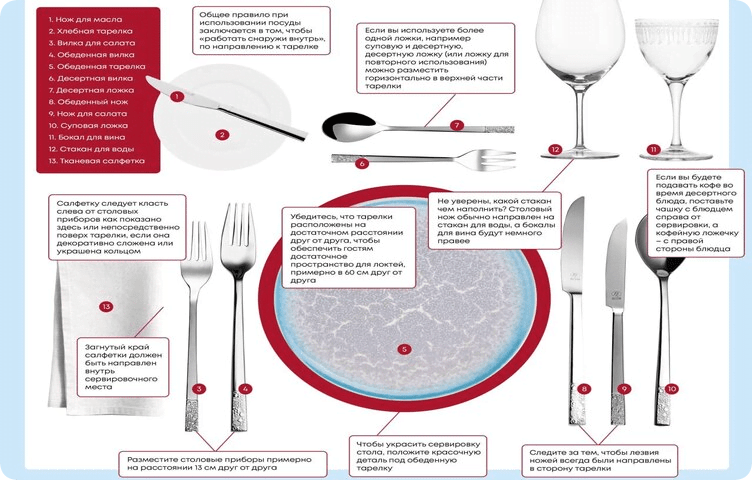
The more dishes are expected to be served, the more extensive the set of cutlery.
In everyday life you can do without a tablecloth. Otherwise, the general rules are followed - a separate plate is placed for each guest. At a festive meal, it serves as a stand. Knives and spoons are placed to the right of her, forks to the left.
Tablecloth
It is customary to cover the table with a beautiful cloth on special occasions. For a small friendly party, a synthetic coating such as oilcloth is acceptable. The color of the product should be in harmony with the shade of the dishes. Light fabrics are selected for bright tableware, and vice versa.
For the most significant events, such as official banquets, snow-white fabric tablecloths are used. A festive item should go down to the floor, an everyday item – 50 cm below the edge of the tabletop.
An interesting addition could be mats for appliances in contrasting colors. At themed events, it is allowed to use individual serving napkins, matched to the interior, bamboo mats, and natural stone stands.
The tablecloth should be perfectly ironed and, for a banquet or wedding, starched. To prevent the product from sliding on the tabletop, a special backing is placed under it.
Dishes
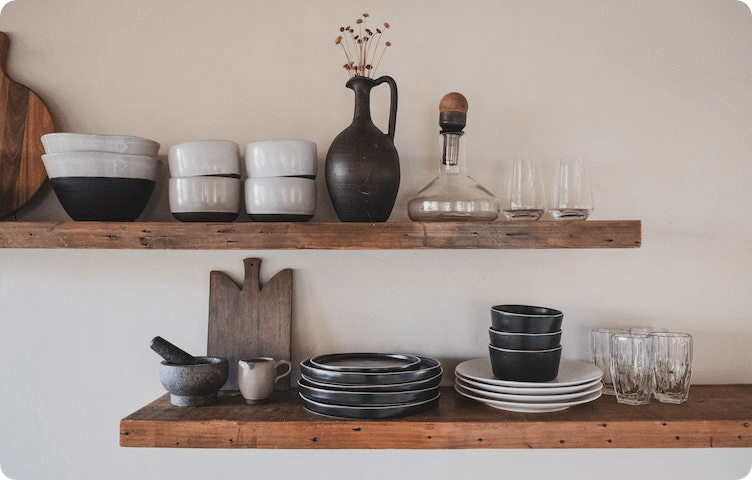
In everyday decoration, 2-3 types of dinnerware are used - for first and second courses , appetizers and desserts . Usually the plates are replaced on the table as the dishes are served. They should be placed 1.5-2 cm from the edge of the tabletop, so that there is 60 cm between the eaters’ utensils.
At a dinner party, a flat serving plate is placed for each guest, and a snack plate with a smaller diameter is placed on it. If soup is included in the menu, the dishes for it are placed on top. A pie plate is placed on the left.
Typically, during a guest meal, 4 types of plates are used, which change as the dishes are served.
Cutlery
This category includes all accessories necessary for eating, including:
spoons - soup, sauce, dessert, tea, coffee, ice cream;
forks – meat, fish, snack, dessert, for lemon;
knives – meat, fish, butter, knife-fork;
tongs – for beans, lobsters, ice.
First, put a basic set of cutlery - a fork on the left, teeth up, a knife on the right, pointing the blade towards the plate, then a spoon. The distance between objects should be 10 mm. If you intend to serve more than three dishes, accessories are added gradually, in accordance with each dish. The butter knife is placed horizontally on the pie plate, with the blade facing inward. A teaspoon or fork is placed in front of the plate, with the handle facing to the right.
Drinkware
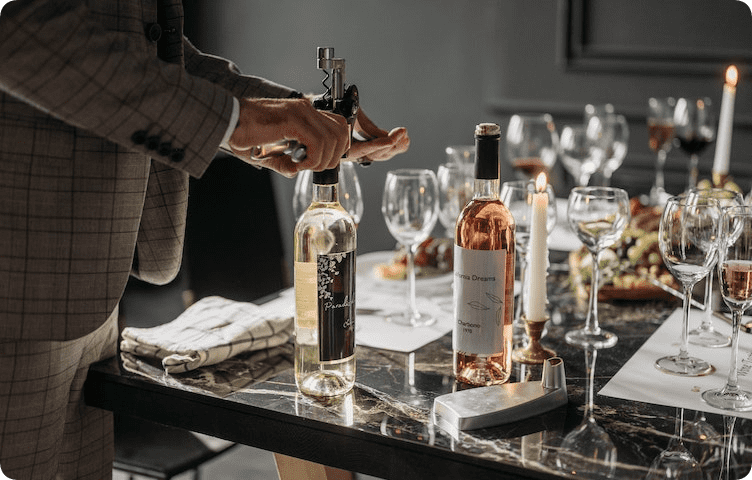
The main object relative to which all other glasses are located is a water glass . It is placed directly in the center in front of each guest’s appliance. On the right is glassware for alcohol, corresponding to the type of drink ( shot glass , wine glass , vodka shot glass ).
At large banquets,where different types of wines are served, glasses in the order in which the drinks are supposed to be poured. As they are used, the wine glasses are removed, except for the water glass - it remains until the end of the meal. All dishes must match each other in material and color.
Hot drinks are served after dessert or at the same time as it. At this point, all other wine glasses should be removed, with the exception of the water glass. Tea or coffee cups are placed to the guest's right. According to the rules of etiquette, they are served on saucers along with paper napkins. If drinks with cognac are expected, the device is supplemented with a cognac glass. Instead of cups, bowls are brought for green tea brewed in the oriental style.
Napkins
Serving involves the use of two types of napkins - paper and fabric . The second option is used in restaurants, as well as during large family celebrations. The etiquette does not clearly define the place of the cloth napkin. It can be placed folded directly on the plate, to the right or left of it.
Here are four more options for accessory placement:
- to the left of the fork, in the form of a tube, triangle or envelope;
- in the middle of the appetizer plate;
- between knife and spoon;
- in the center, parallel to the dessert fork.
At festive banquets, fabric napkins are folded into decorative figures and decorated with special rings.
Etiquette allows you to vary the placement of paper napkins. They can lie under a knife and spoon, on top of a pie plate. At large receptions, napkin holders filled with paper products are often used, placing them at a convenient distance from the guests.
Decor
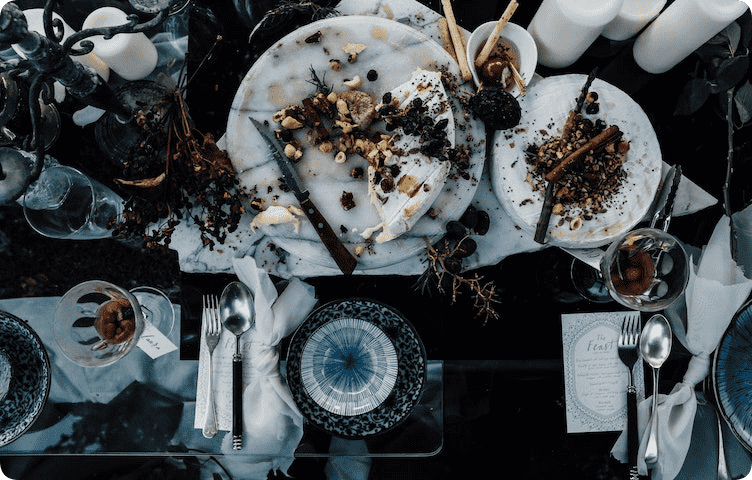
Decorations add elements of aesthetics to the setting, highlight the theme and create a special mood for the meal. Decorative items are placed in the center of the tabletop. They should be in harmony in style and color with the dishes, tablecloth and general interior of the room.
Classic decoration options - a vase with flowers, candles in a candlestick . Modern food designers offer unusual decor, including:
- fruits floating in a transparent vessel;
- Candy stand;
- compositions of fruits and nuts;
- paper pompoms;
- tree branches.
Seasonal decorations also look good - spruce branches with cones for the New Year, compositions of painted eggs for Easter.
Etiquette requires that the decor does not block the guests' view and is proportional to the size of the table. On round countertops, it is correct to use no more than one central element. For long rectangular furniture, it is recommended to place one decorative item every 1-1.5 m.
Fabric napkins, rings and placemats are also design elements. Their color and shape must be taken into account in the overall composition.
Cookware and utensils for spices
In addition to individual accessories for each guest, items for sharing are needed on the table:
- salt shakers ;
- pepper shakers ;
- gravy boats ;
- jars of mustard.
They are located in the center of the table, so that it is easy for each guest to reach. At large banquets, spices are placed every 1-1.5 m. Each set should be on a stand or saucer.
Before serving dessert and hot drinks, sugar bowls, creamers, and saucers with sliced lemon are brought. These products are also placed in the middle of the table.
Rules for table setting in a restaurant
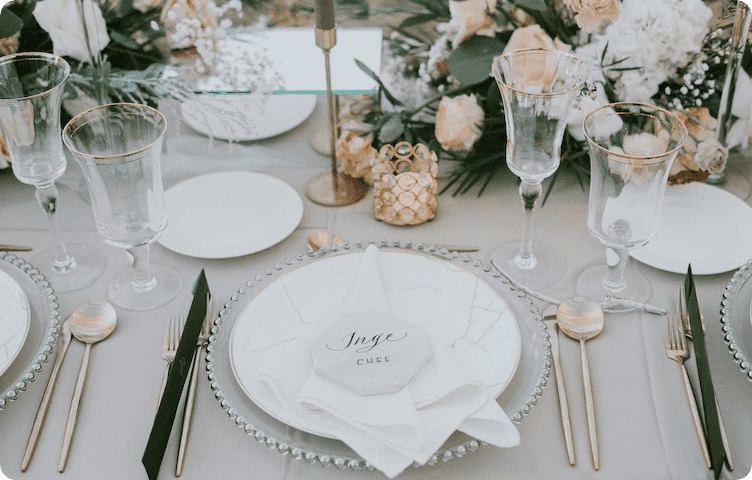
Each establishment develops its own concept for serving and decorating dishes. In this case, one of the classical serving methods is selected, which the waiters are required to follow.
Let us briefly present the features of these methods:
standard – used in everyday life of the restaurant. Involves the use of a basic set of serving plate, fork, knife, water glass and napkin. Can be complemented with decor from seasonal flowers and the symbols of the establishment. Often used in cafes and family restaurants. Standard serving is easy to repeat at home.
banquet - popular at celebrations with a large number of guests, including weddings and anniversaries. EtcIbors are served for three courses - starter, main course, dessert. Before the meal begins, two plates are placed on the table, a serving plate and a pie plate. Salad and meat forks are placed on the left, a leg, a soup spoon, and a teaspoon are placed on the right. In front of each device there is a glass of water and a wine glass. Place a butter knife on the pie plate. The central part of the table is usually occupied by common salad bowls and snack dishes, from which guests can take food themselves.
full - the method is used at official banquets, elite receptions, as well as in gourmet restaurants. The set of dishes and cutlery is designed for 6 dishes. It includes at least two plates, three glasses for cold drinks, 9 cutlery and a cup and saucer for hot drinks. The types of accessories depend on the menu, which may include soup, salad, meat and fish dishes, dessert, white and red wines. An important design element is a card with the guest’s name, which is placed on the serving plate. The middle of the table is decorated with flower arrangements, figurines, and candles. The design is complemented by decoratively folded starched napkins.
With any serving method, guests’ cutlery is placed at a distance of 50-80 cm from each other.
During lunch or dinner, waiters remove some of the dishes, adding new items. According to the serving of dishes, additional accessories are served, for example, crab forks, salad tongs, and jellied spatulas. Before dessert, the table is completely cleared, leaving only glasses for water.
Each restaurant adds its own elements to create a unique atmosphere. These can be compositions of seasonal flowers, coasters for plates made of natural materials, branded napkins. The serving rules take into account the national and thematic characteristics of the restaurant. Thus, in eastern establishments they use a free arrangement of objects on the table. French etiquette allows the pie plate to be placed on the left, and the fork to be placed with the tines down.
















































/https%3A%2F%2Fcomplexbar.com%2Fimages%2Fblog%2F132%2Fservirovka.jpg)
/https%3A%2F%2Fcomplexbar.com%2Fimages%2Fblog%2F246%2Fsirop_scale_2400.jpeg)
/https%3A%2F%2Fcomplexbar.com%2Fimages%2Fblog%2F246%2Fkofe-vostochniy.jpg)
/https%3A%2F%2Fcomplexbar.com%2Fimages%2Fblog%2F245%2Fpexels-jason-villanueva-851555.jpg)
/https%3A%2F%2Fcomplexbar.com%2Fimages%2Fblog%2F246%2F2024-04-09_17.22.54.jpg)
/https%3A%2F%2Fcomplexbar.com%2Fimages%2Fblog%2F246%2F2024-04-09_17.22.47.jpg)
/https%3A%2F%2Fcomplexbar.com%2Fimages%2Fblog%2F246%2FCODE_anons_foamydrops_752%D1%85480_eng.jpg)
/https%3A%2F%2Fcomplexbar.com%2Fimages%2Fblog%2F246%2FAlina_752%D1%85480_eng.jpg)
/https%3A%2F%2Fcomplexbar.com%2Fimages%2Fblog%2F246%2F2024-04-09_17.23.22.jpg)
/https%3A%2F%2Fcomplexbar.com%2Fimages%2Fblog%2F246%2F2024-04-09_17.23.28.jpg)
/https%3A%2F%2Fcomplexbar.com%2Fimages%2Fblog%2F246%2F2024-04-09_17.23.35.jpg)
/https%3A%2F%2Fcomplexbar.com%2Fimages%2Fblog%2F246%2Fdrinksome_752%D1%85480_eng.jpg)
/https%3A%2F%2Fcomplexbar.com%2Fimages%2Fblog%2F246%2Fnude_752%D1%85480_eng.jpg)
/https%3A%2F%2Fcomplexbar.com%2Fimages%2Fblog%2F246%2F752%D1%85480_eng__1_.jpg)
/https%3A%2F%2Fcomplexbar.com%2Fimages%2Fblog%2F246%2F752%D1%85480_eng.jpg)
/https%3A%2F%2Fcomplexbar.com%2Fimages%2Fblog%2F246%2FStudioRaw_752%D1%85480_eng.jpg)
/https%3A%2F%2Fcomplexbar.com%2Fimages%2Fblog%2F246%2FDoppio_tea_752%D1%85480_eng.jpg)
/https%3A%2F%2Fcomplexbar.com%2Fimages%2Fblog%2F246%2FTognana_Stars_Stripes_752%D1%85480_eng.jpg)
/https%3A%2F%2Fcomplexbar.com%2Fimages%2Fblog%2F246%2FRona_752%D1%85480_eng.jpg)
/https%3A%2F%2Fcomplexbar.com%2Fimages%2Fblog%2F246%2FDoppio_vending_752%D1%85480_eng.jpg)
/https%3A%2F%2Fcomplexbar.com%2Fimages%2Fblog%2F246%2FEssence_sukhie_smesi_752%D1%85480_eng.jpg)
/https%3A%2F%2Fcomplexbar.com%2Fimages%2Fblog%2F246%2FODK_sukhie_smesi752%D1%85480_eng.jpg)
/https%3A%2F%2Fcomplexbar.com%2Fimages%2Fblog%2F246%2Funiforma-barmena.jpg)
/https%3A%2F%2Fcomplexbar.com%2Fimages%2Fblog%2F246%2Fkak-nanyat-barmena.jpg)
/https%3A%2F%2Fcomplexbar.com%2Fimages%2Fblog%2F246%2Fsirop_scale_2400.jpeg)
/https%3A%2F%2Fcomplexbar.com%2Fimages%2Fblog%2F246%2FPeugeot_Anons_Paris_U%27Select_Line_Daman_752%D1%85480_eng.jpg)
/https%3A%2F%2Fcomplexbar.com%2Fimages%2Fblog%2F246%2Fkofe-vostochniy.jpg)
/https%3A%2F%2Fcomplexbar.com%2Fimages%2Fblog%2F246%2FMadler.jpg)
/https%3A%2F%2Fcomplexbar.com%2Fimages%2Fblog%2F246%2Fprofbartender_glavn.jpeg)